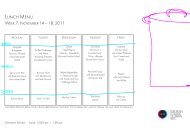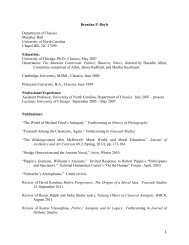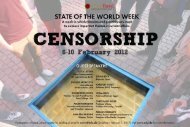What is (modern) Art? - European College of Liberal Arts, Berlin
What is (modern) Art? - European College of Liberal Arts, Berlin
What is (modern) Art? - European College of Liberal Arts, Berlin
Create successful ePaper yourself
Turn your PDF publications into a flip-book with our unique Google optimized e-Paper software.
Aya Soika (<strong>of</strong>fice: P 98)<br />
Contact: a.soika@ecla.de<br />
Times: Wednesday, 13:30 – 15:00 (ECLA); Friday: 13:30 – 15:00 (ECLA and museums)<br />
Concentration requirements: <strong>Art</strong>s and Aesthetics<br />
D<strong>is</strong>tribution Requirements: Periods/Places<br />
<strong>What</strong> <strong>is</strong> (<strong>modern</strong>) <strong>Art</strong>?<br />
Th<strong>is</strong> class d<strong>is</strong>cusses the changing significance <strong>of</strong> art in the nineteenth and twentieth<br />
centuries. In addition to acquainting students with new modes <strong>of</strong> pictorial<br />
representation and the re-definition <strong>of</strong> art<strong>is</strong>tic practices, one <strong>of</strong> its goals <strong>is</strong> to introduce<br />
students to the h<strong>is</strong>torical conditions and problems connected with the advent <strong>of</strong><br />
<strong>modern</strong><strong>is</strong>m in the v<strong>is</strong>ual arts. Definitions <strong>of</strong> what constitutes the '<strong>modern</strong>' or 'avantgarde'<br />
status <strong>of</strong> works <strong>of</strong> art are manifold. Primary sources, such as contemporary<br />
reviews, art<strong>is</strong>ts’ letters and manifestos shed light on the intentions, rhetoric and public<br />
reception <strong>of</strong> radical art<strong>is</strong>tic projects at the emergence <strong>of</strong> <strong>modern</strong><strong>is</strong>m. Later art h<strong>is</strong>torical<br />
interpretations - ranging from formal<strong>is</strong>t approaches to investigations into the social and<br />
political conditions <strong>of</strong> <strong>modern</strong> life – help to establ<strong>is</strong>h conceptual frameworks within<br />
which individual works can be placed and understood. V<strong>is</strong>its to <strong>Berlin</strong>’s major<br />
collections <strong>of</strong> <strong>modern</strong> art are an integral part <strong>of</strong> the course syllabus.<br />
Above: The original Fountain by Marcel Duchamp, 1917, photographed by Alfred Stieglitz.<br />
1
READING & OTHER TASKS<br />
COURSE REQUIREMENTS<br />
For th<strong>is</strong> class attendance <strong>is</strong> mandatory. Reading assignments have to be done in advance <strong>of</strong> class.<br />
In addition to the general preparatory reading, there will be a variety <strong>of</strong> tasks, such as the<br />
preparation <strong>of</strong> paintings or text passages before some classes. Students will be provided with<br />
several relevant books which provide further (voluntary) background reading in addition to the<br />
weekly reading assignments.<br />
VISUAL ART EXERCISE<br />
There will be one v<strong>is</strong>ual art analys<strong>is</strong> exerc<strong>is</strong>e in mid-term which will feature a range <strong>of</strong> works<br />
d<strong>is</strong>cussed in class and in museums. D<strong>is</strong>cussions <strong>of</strong> individual slides should be short and relevant,<br />
in the form <strong>of</strong> bullet points, rendering specific information which relate to class d<strong>is</strong>cussion,<br />
readings and further context.<br />
PRESENTATIONS<br />
Each student will deliver two presentations, in class or/and in the museums. One <strong>of</strong> the<br />
presentations will introduce a specific text from the weekly reading, the other will focus on the<br />
v<strong>is</strong>ual analys<strong>is</strong> and interpretation <strong>of</strong> a particular work. The presentations also reflect upon the<br />
work in the larger context <strong>of</strong> shifting notions <strong>of</strong> representation and, in the case <strong>of</strong> the text, on the<br />
h<strong>is</strong>torical context in which the text was written. Presentations should last no longer than fifteen<br />
minutes.<br />
ESSAY<br />
There will be a long essay (4.200 words minimum), due towards the end <strong>of</strong> term. Students<br />
will d<strong>is</strong>cuss a clearly confined topic – which they are free to choose in consultation with me -<br />
with reference to specific art works and some <strong>of</strong> the texts we have read.<br />
EVAULATION<br />
Seminar Grade = Attendance/Participation/Preparation <strong>of</strong> <strong>Art</strong> Works and Texts & Tasks<br />
Seminar Grade (weeks 1-7): 20%<br />
Seminar Grade (weeks 8-14): 20%<br />
V<strong>is</strong>ual Analys<strong>is</strong> exerc<strong>is</strong>e I: 15%<br />
Presentations I & II (together): 15%<br />
Grade for Final Paper: 30%<br />
2
WEEKLY SCHEDULE<br />
Week 1 (5 th September)<br />
Introduction, with Ge<strong>of</strong>f Lehman (Concentration Seminar Leader <strong>of</strong> the Spring<br />
Semester)<br />
Works:<br />
Kasimir Malevich, Red Square. Painterly Real<strong>is</strong>m <strong>of</strong> a peasant woman in two Dimensions, 1915<br />
Magritte’s The treachery <strong>of</strong> images, 1928-29<br />
John Baldessari, Everything <strong>is</strong> purged from th<strong>is</strong> painting but art, no ideas have entered th<strong>is</strong> work, 1966-<br />
1968<br />
Reading:<br />
For th<strong>is</strong> semester you have been provided with various course books (Belting, Danto, Wood, E<strong>is</strong>enman,<br />
Gombrich), two anthologies and a reader (see bibliography and l<strong>is</strong>t <strong>of</strong> course books at the end <strong>of</strong> th<strong>is</strong><br />
document). Please use the first week to start familiar<strong>is</strong>ing yourself with the structure and themes <strong>of</strong> the<br />
books, and with the different approaches outlined in them. Although we will only be able to d<strong>is</strong>cuss<br />
selected chapters <strong>of</strong> these books in class you are encouraged to gain further background by exploring<br />
some <strong>of</strong> the themes in greater depth on your own.<br />
[Friday, 7 th : Aya in Canterbury, no class – there will be a double session in week 3]<br />
René Magritte, The treachery <strong>of</strong> images, 1928-29. Los Angeles County Museum <strong>of</strong> <strong>Art</strong><br />
3
Week 2<br />
(12 th /14 th September)<br />
After the End <strong>of</strong> <strong>Art</strong>: Retrospective Reflections by <strong>Art</strong>hur Danto<br />
An Introduction to art h<strong>is</strong>tory’s “Master Narratives”<br />
Reading:<br />
<strong>Art</strong>hur Danto: Introduction: Modern, Post<strong>modern</strong>, Contemporary. In: After the End <strong>of</strong> <strong>Art</strong>, pp. 2-19<br />
Plato, Book X <strong>of</strong> the Republic (in the reader)<br />
Hans Belting’s <strong>Art</strong> H<strong>is</strong>toriography<br />
Reading:<br />
Hans Belting, Epilogues for <strong>Art</strong> or for <strong>Art</strong> H<strong>is</strong>tory?. Chapter 1 in: Hans Belting, <strong>Art</strong> H<strong>is</strong>tory after Modern<strong>is</strong>m,<br />
(Engl<strong>is</strong>h translation) Chicago 2003, pp. 3-6;<br />
Hans Belting, The Meaning for <strong>Art</strong> H<strong>is</strong>tory in today’s Culture. Chapter 2 in: Hans Belting, <strong>Art</strong> H<strong>is</strong>tory after<br />
Modern<strong>is</strong>m, (Engl<strong>is</strong>h translation) Chicago 2003, pp. 7-16;<br />
Hans Belting, <strong>Art</strong> Critic<strong>is</strong>m versus <strong>Art</strong> H<strong>is</strong>tory. Chapter 3 in: Hans Belting, <strong>Art</strong> H<strong>is</strong>tory after Modern<strong>is</strong>m,<br />
(Engl<strong>is</strong>h translation) Chicago 2003, pp. 17-25;<br />
Hans Belting, <strong>Art</strong> H<strong>is</strong>toriography as Tradition. Chapter 13 in: Hans Belting, <strong>Art</strong> H<strong>is</strong>tory after Modern<strong>is</strong>m,<br />
(Engl<strong>is</strong>h translation) Chicago 2003, pp. 126-136<br />
4
Week 3<br />
(19 th /21 st September)<br />
The Reading <strong>of</strong> Images and the Role <strong>of</strong> Context<br />
Erwin Pan<strong>of</strong>sky: Iconography and Iconology<br />
Reading:<br />
Erwin Pan<strong>of</strong>sky, Studies in Iconology. Human<strong>is</strong>tic Themes in the <strong>Art</strong> <strong>of</strong> the Rena<strong>is</strong>sance, Introduction, pp.<br />
4-31 (Reader)<br />
V<strong>is</strong>it to Gemäldegalerie<br />
Double Session to make up for Week 1<br />
Works in the “Northern” section:<br />
Westphalian Crucifixion Altarpiece from Soest, ca. 1230/40<br />
Hans Multscher, The Wings <strong>of</strong> the Wurzach Altar, 1437<br />
Master <strong>of</strong> the Housebook, The Washing <strong>of</strong> the Apostles’ Feet<br />
The Last Supper, ca. 1475/80<br />
Albrecht Dürer, The Madonna with the S<strong>is</strong>kin, 1505<br />
Lucas Cranach the Elder, The Fountain <strong>of</strong> Youth, 1546<br />
Hans Holbein the Younger, The Merchant Georg G<strong>is</strong>ze, 1532<br />
Jan van Eyck, The Madonna in the Church, ca. 1425<br />
Works in the Italian section:<br />
Giotto di Bondone, The Entombment <strong>of</strong> Mary, ca. 1310<br />
Gentile da Fabriano, Mary enthroned with the Child, Saints and Donor, 1837<br />
Piero della Francesca, The Penitent St. Jerome, 1450<br />
Domenica Veneziano, The Adoration <strong>of</strong> the Kings, ca. 1439/41<br />
Piero del Pollaiuolo, The Annunciation, ca. 1470<br />
Background Reading:<br />
Ernst Gombrich, Chapters on the Rena<strong>is</strong>sance. In: The Story <strong>of</strong> <strong>Art</strong><br />
5
Week 4<br />
(26 th /28 th September)<br />
The romantic V<strong>is</strong>ion in Context: <strong>Art</strong> and the Nation<br />
Works:<br />
Georg Friedrich Kersting, The Wreath Binder (Die Kranzbinderin), 1815<br />
Georg Friedrich Kersting, On Outpost Duty, 1815<br />
Georg Friedrich Kersting, Friedrich in h<strong>is</strong> studio, 1819<br />
Caspar David Friedrich: Monk by the Sea, 1808-10<br />
Caspar David Friedrich: Abbey in the oak forest, 1809-10<br />
Caspar David Friedrich, Chalk Cliffs <strong>of</strong> Rügen, ca. 1818-19<br />
Caspar David Friedrich, Wanderer above the Sea <strong>of</strong> Fog, ca. 1819<br />
Caspar David Friedrich, Woman at the Window, 1822<br />
Theodore Gericault, The Raft <strong>of</strong> the Medusa, 1819<br />
Eugene Delacroix, The 28 th <strong>of</strong> July: Liberty leading the people, 1830<br />
Eugene Delacroix: The Bark <strong>of</strong> Dante and Virgil, 1822<br />
Reading:<br />
Caspar David Friedrich: Observations on viewing a collection <strong>of</strong> paintings…, ca. 1830. In: <strong>Art</strong> in Theory,<br />
1815-1900, ed. C. Harr<strong>is</strong>on, pp. 48-54;<br />
Franco<strong>is</strong>e Forster-Hahn: <strong>Art</strong> without a national centre. German painting in the nineteenth century. In:<br />
Spirit <strong>of</strong> an Age, 2001, pp. 19-39;<br />
Thomas Crow: Classic<strong>is</strong>m in Cr<strong>is</strong><strong>is</strong>: Gros to Delacroix. In: Stephen E<strong>is</strong>enman: Nineteenth Century <strong>Art</strong>… .<br />
V<strong>is</strong>it to Alte Nationalgalerie (Nazarenes vs. C. D. Friedrich)<br />
Works:<br />
Karl Friedrich Schinkel: Medieval City on a River, 1815<br />
Karl Friedrich Schinkel: A view <strong>of</strong> Greece in the Golden Age, 1825<br />
Caspar David Friedrich: Monk by the Sea, 1808-10<br />
Caspar David Friedrich: Abbey in the oak forest, 1809-10<br />
Caspar David Friedrich: Oak Tree in the Snow, 1829<br />
Caspar David Friedrich, Woman at the Window, 1822<br />
Caspar David Friedrich, The solitary Tree, 1822<br />
Caspar David Friedrich, Moonr<strong>is</strong>e over the Sea, 1822<br />
Reading:<br />
Romantic Landscape/Catalogue. In: Spirit <strong>of</strong> an Age, 2001, pp. 58-77<br />
6
Week 5<br />
(10 th / 12 th October)<br />
The Birth <strong>of</strong> the Avantgarde in 19 th century Par<strong>is</strong> and <strong>Berlin</strong>: Real<strong>is</strong>m<br />
Paintings:<br />
Gustave Courbet, The Stonebreakers, 1850<br />
Gustave Courbet, The Studio <strong>of</strong> the painter: A real Allegory summing up seven years <strong>of</strong> my art<strong>is</strong>tic Life,<br />
1854-5<br />
Gustave Courbet, A Burial at Ornans, 1849<br />
Gustave Courbet, The meeting, 1854<br />
Gustave Courbet, Peasants <strong>of</strong> Flagey returning from the Fair, 1849<br />
Reading:<br />
T. J. Clark on Courbet, On the social H<strong>is</strong>tory <strong>of</strong> <strong>Art</strong>. In: Image <strong>of</strong> the people. Gustave Courbet and the 1848<br />
Revolution. London 1973, pp. 9-20;<br />
Text: Max Buchon: On Courbet’s Stonebreakers and Burial at Ornans, 1850. In: <strong>Art</strong> in Theory, 1815-1900,<br />
ed. C. Harr<strong>is</strong>on, pp. 364-6.<br />
Background Reading:<br />
Paul Wood: The avant-garde from the July Monarchy to the Second Empire. In: Paul Wood (ed.), The<br />
Challenge <strong>of</strong> the Avant-Garde. New Haven 1999, pp. 35-55.<br />
Stephen E<strong>is</strong>enman: The Rhetoric <strong>of</strong> Real<strong>is</strong>m: Courbet and the origins <strong>of</strong> the Avant-Garde. In: Nineteenth<br />
Century <strong>Art</strong>…<br />
V<strong>is</strong>it to Alte Nationalgalerie (Real<strong>is</strong>m and Impression<strong>is</strong>m)<br />
Paintings:<br />
Adolph Menzel, Balcony Room, 1845<br />
Adolph Menzel, The <strong>Berlin</strong>-Potsdam Railway, 1847<br />
Adolph Menzel, Flute Concert, 1850-2<br />
Adolph Menzel: Iron Rolling Mill, 1872-5<br />
Adolph Menzel: The Foot <strong>of</strong> the <strong>Art</strong><strong>is</strong>t, 1876<br />
Claude Monet, St. German l’Auxerro<strong>is</strong>, 1867<br />
Claude Monet, Summer, 1874<br />
Claude Monet, View <strong>of</strong> Vétheuil, 1880<br />
Edouard Manet, In the conservatory, 1879<br />
Edouart Manet, Mansion in Rueil, 1882<br />
Reading:<br />
Jason Gaiger: Modernity in Germany: the many sides <strong>of</strong> Adolph Menzel. In: Paul Wood (ed.), The Challenge<br />
<strong>of</strong> the Avant-Garde. New Haven 1999, pp. 91-111;<br />
Catalogue/Colour, Light and Air; Catalogue/The Ka<strong>is</strong>erzeit. In: Spirit <strong>of</strong> an Age, 2001, pp. 94-115; 128-141;<br />
Embracing the French Avant-garde. In: Spirit <strong>of</strong> an Age, 2001, pp. 166-175<br />
7
Week 6<br />
(17 th / 19 th October)<br />
Critical Approaches and Reception H<strong>is</strong>tory: Impression<strong>is</strong>m and Post-Impression<strong>is</strong>m<br />
The Painter <strong>of</strong> <strong>modern</strong> Life<br />
Paintings:<br />
Edouard Manet, The Old Musician, 1862<br />
Edouar Manet, Luncheon on the Grass, 1863<br />
Edouard Manet, A Balcony, 1868-9<br />
Edouard Manet, Olympia, 1863<br />
Edouard Manet, Argenteuil, les canotiers (The Boaters, Argenteuil), 1874<br />
Edouard Manet, In the Winter Garden, 1879<br />
Edouard Manet, A Car at the Folies-Bergère, ca. 1882<br />
Reading:<br />
T. J. Clark, Preliminaries to a possible treatment <strong>of</strong> „Olympia“ in 1865. In: Screen, vol. 21, 1980, pp. 18-41<br />
(Reader);<br />
Charles Baudelaire, from “The Painter <strong>of</strong> Modern Life”, 1859-63. In: <strong>Art</strong> in Theory, 1815-1900, ed. C.<br />
Harr<strong>is</strong>on, pp. 493-506<br />
Background Reading:<br />
Stephen E<strong>is</strong>enman, Manet and the Impression<strong>is</strong>ts. In: Nineteenth Century <strong>Art</strong>…<br />
A critical d<strong>is</strong>cussion <strong>of</strong> the term “Post-Impression<strong>is</strong>m” / The case <strong>of</strong> Paul Gauguin<br />
Paintings:<br />
Emile Bernard, Breton Women at the Pardon, 1888<br />
Emile Bernard, The Buckwheat Harvest, 1888<br />
Pascal Dagnan-Bouveret, Le Pardon en Bretagne (The Pardon in Brittany), 1886<br />
Paul Gauguin, Two fighting Boys, 1888<br />
Paul Gauguin, The V<strong>is</strong>ion after the Sermon. Jacob wrestling with the Angel, 1889<br />
Paul Gauguin, Agony in the Garden: Chr<strong>is</strong>t in the Garden <strong>of</strong> Olives, 1889<br />
Reading:<br />
Gr<strong>is</strong>elda Pollock & Fred Orton: Post-Impression<strong>is</strong>m: Les Donnes Bretonnantes: La Prairie de la<br />
Representation. In: <strong>Art</strong> H<strong>is</strong>tory, 3, 3, 1980, pp. 314-344 (Reader).<br />
Background Reading:<br />
Gill Perry, Exhibiting “les Independants”: Gauguin and the Cafe Volpini show. In: Paul Wood (ed.), The<br />
Challenge <strong>of</strong> the Avant-Garde, pp. 164-181;<br />
Stephen E<strong>is</strong>enman: Symbol<strong>is</strong>m and the dialectics <strong>of</strong> retreat (relevant sections). In: Nineteenth Century<br />
<strong>Art</strong>…. (sections on Britanny).<br />
8
Week 7<br />
(24 th / 26 th October)<br />
Modern Times: Primitiv<strong>is</strong>m and Colonial<strong>is</strong>m<br />
Works:<br />
Pablo Picasso, Les Demo<strong>is</strong>elles d`Avignon, 1907, Museum <strong>of</strong> Modern <strong>Art</strong>, New York<br />
Henri Mat<strong>is</strong>se, Nu bleu. Souvenir de B<strong>is</strong>kra (Blue Nude. Souvenir <strong>of</strong> B<strong>is</strong>kra), 1907, Philadelphia Museum<br />
Henri Mat<strong>is</strong>se, Bathers with a Turtle, 1908, St Lou<strong>is</strong> <strong>Art</strong> Museum<br />
Ernst Ludwig Kirchner, Bathers at Moritzburg, 1909/1926, Tate Gallery London<br />
Emil Nolde, Papua Boys, 1914, Neue Nationalgalerie<br />
Reading:<br />
Franz Marc, The Savages <strong>of</strong> Germany, and Two Pictures. In: Charles Harr<strong>is</strong>on & Paul Wood (eds), <strong>Art</strong> in<br />
Theory. 1900-2000. An Anthology <strong>of</strong> Changing Ideas. Oxford 2002, Ib/9;<br />
Paul Wood, The avant-garde in the early twentieth century. In: Paul Wood (ed.), The Challenge <strong>of</strong> the<br />
Avant-Garde, pp. 183-203;<br />
Hal Foster, “Primitive Scenes”. In: Critical Inquiry, vol. 20, no. 1, 1993, pp. 69-102 (available via Jstor);<br />
Hans Belting, Marco Polo and other Cultures. Chapter 20 in: Hans Belting, <strong>Art</strong> H<strong>is</strong>tory after Modern<strong>is</strong>m,<br />
(Engl<strong>is</strong>h translation) Chicago 2003, pp. 192-200.<br />
Further background:<br />
[Hal Foster, The “Primitive” Unconscious <strong>of</strong> Modern <strong>Art</strong>. In: October, vol. 34, 1985, pp. 45-70 (available on<br />
Jstor);<br />
Anna C. Chave, New Encounters with Les Demo<strong>is</strong>elles d’Avignon: Gender, Race, and the Origins <strong>of</strong> Cub<strong>is</strong>m,<br />
in: The <strong>Art</strong> Bulletin, 76, no. 4, 1994, pp. 596-611 (available via Jstor)]<br />
Modern Times: Futur<strong>is</strong>t V<strong>is</strong>ions and reactions to the First World War<br />
Works:<br />
Umberto Boccioni, The City R<strong>is</strong>es, 199 x 301 cm, 1910, Moma New York<br />
Umberto Boccioni, The Street enters the House, 1911, Sprengel Museum Hannover<br />
Umberto Boccioni, States <strong>of</strong> Mind I: The Farewells, 1911, Moma New York<br />
Umberto Boccioni, States <strong>of</strong> Mind II: Those who go, 1911, Moma New York<br />
Giacomo Balla, Dynam<strong>is</strong>m <strong>of</strong> a Dog on a Leash, 1912, Albright-Knox <strong>Art</strong> Gallery, Buffalo<br />
Gino Severini, Suburban Train arriving in Par<strong>is</strong>, 1915, oil on Canvas, Tate Gallery London<br />
Ernst Ludwig Kirchner, Potsdamer Platz, 1914<br />
Ernst Ludwig Kirchner, Self Portrait, 1915<br />
Ernst Ludwig Kirchner, <strong>Art</strong>illery Men in the Shower, 1915<br />
Otto Dix, Der Krieg, Series <strong>of</strong> Etchings, 1923<br />
Reading:<br />
Filippo Tommaso Marinetti, The Foundation and Manifesto <strong>of</strong> Futur<strong>is</strong>m. In: <strong>Art</strong> in Theory, 1900-2000<br />
(IIa/6);<br />
Umberto Boccioni et al., Futur<strong>is</strong>t Painting: Technical Manifesto. In: <strong>Art</strong> in Theory, 1900-2000 (IIa/7);<br />
The Futur<strong>is</strong>ts: Transcontinental avant-gard<strong>is</strong>m. In: Paul Wood (ed.), The Challenge <strong>of</strong> the Avant-Garde, pp.<br />
204-225<br />
9
Week 8<br />
(31 st October / 2 nd November)<br />
Greenberg’s Modern<strong>is</strong>m and its Limits<br />
Map:<br />
Alfred Barr, Chart <strong>of</strong> the Exhibition Catalogue Cover: Cub<strong>is</strong>m and Abstract <strong>Art</strong>, 1936, Museum <strong>of</strong> Modern<br />
<strong>Art</strong> New York<br />
Reading:<br />
Clement Greenberg: Modern<strong>is</strong>t Painting. In: <strong>Art</strong> and Literature, 4, 1965, pp. 193-201.<br />
<strong>Art</strong>hur Danto: Modern<strong>is</strong>m and the Critique <strong>of</strong> Pure <strong>Art</strong>: The H<strong>is</strong>torical V<strong>is</strong>ion <strong>of</strong> Clement Greenberg. In:<br />
After the End <strong>of</strong> <strong>Art</strong>, pp. 60-78<br />
V<strong>is</strong>ual <strong>Art</strong> Quiz<br />
Responses to Greenberg<br />
Reading:<br />
[<strong>Art</strong>hur Danto: Introduction: Modern, Post<strong>modern</strong>, Contemporary. In: After the End <strong>of</strong> <strong>Art</strong>, pp. 2-19];<br />
<strong>Art</strong>hur Danto: Modern<strong>is</strong>m and the Critique <strong>of</strong> Pure <strong>Art</strong>: The H<strong>is</strong>torical V<strong>is</strong>ion <strong>of</strong> Clement Greenberg. In:<br />
After the End <strong>of</strong> <strong>Art</strong>, pp. 60-78<br />
10
Week 9<br />
(7 th / 10 th November)<br />
Monochrome and Abstract Painting<br />
Works:<br />
Kasimir Malevich, An Engl<strong>is</strong>hman in Moscow, 1913-1914, Stedelijk Museum Amsterdam<br />
Kasimir Malevich, Black Square, 1915, Tretyakov Gallery Moscow<br />
Wassily Kandinsky, Improv<strong>is</strong>ation 19, 1911, Städt<strong>is</strong>che Galerie im Lenbachhaus München<br />
Works by Jackson Pollock, Mark Rothko, Yves Klein, Lucio Fontana<br />
Reading:<br />
Kasimir Malevich, From Cub<strong>is</strong>m and Futur<strong>is</strong>m to Supremat<strong>is</strong>m: The New Real<strong>is</strong>m in Painting, 1915-16. In:<br />
Charles Harr<strong>is</strong>on & Paul Wood (eds), <strong>Art</strong> in Theory. 1900-2000. An Anthology <strong>of</strong> Changing Ideas. Oxford<br />
2002, Part IIA/14;<br />
Wassily Kandinsky, On the Spiritual in <strong>Art</strong>. In: Charles Harr<strong>is</strong>on & Paul Wood (eds), <strong>Art</strong> in Theory. 1900-<br />
2000. An Anthology <strong>of</strong> Changing Ideas. Oxford 2002, Ib/7<br />
Background Reading:<br />
<strong>Art</strong>hur Danto, The h<strong>is</strong>torical Museum <strong>of</strong> monochrome <strong>Art</strong>. In: After the End <strong>of</strong> <strong>Art</strong>, pp. 153-173.<br />
Saturday: V<strong>is</strong>it to Museum Berggruen & Collection Scharf-Gerstenberg [Double Session]<br />
Week 10<br />
(14 th November)<br />
Montage and the Readymade<br />
Works:<br />
Hannah Höch, Schnitt mit dem Küchenmesser Dada durch die letzte Weimarer Bierbauchkulturepoche<br />
Deutschlands (Cut with the Kitchen Knife Dada through the last Weimar Beer-Belly Cultural Epoch <strong>of</strong><br />
Germany), 1919-1920, Neue Nationalgalerie<br />
Raoul Hausmann, Mechanical Head: The Spirit <strong>of</strong> Our Age, 1921, Musee d’art <strong>modern</strong>e, Par<strong>is</strong><br />
Marcel Duchamp, Bottle Rack, 1914<br />
Marcel Duchamp, Fountain, 1917<br />
Marcel Duchamp, L. H. O. O. Q., 1941-42<br />
Reading:<br />
Marcel Duchamp, The Richard Mutt Case, 1917. In: <strong>Art</strong> in Theory, 1900-2000 (IIIb/2)<br />
Tr<strong>is</strong>tan Tzara, Dada Manifesto 1918, In: <strong>Art</strong> in Theory, 1900-2000 (IIIb/3);<br />
Richard Huelsenbeck: First German Dada Manifesto, 1918;<br />
Richard Huelsenbeck and Raoul Hausmann: <strong>What</strong> <strong>is</strong> Dada<strong>is</strong>m and what does it want in Germany?, 1919;<br />
Richard Huelsenbeck: En Avant Dada, 1920. All in: Charles Harr<strong>is</strong>on & Paul Wood (eds), <strong>Art</strong> in Theory.<br />
1900-2000. An Anthology <strong>of</strong> Changing Ideas. Oxford 2002, pp. 257-263;<br />
Background Reading:<br />
Hans Belting, The Unwelcome Heritage <strong>of</strong> Modern<strong>is</strong>m: Style and H<strong>is</strong>tory. Chapter 4 in: Hans Belting, <strong>Art</strong><br />
H<strong>is</strong>tory after Modern<strong>is</strong>m, (Engl<strong>is</strong>h translation) Chicago 2003, pp. 26-36.<br />
16 th November, Friday: No class<br />
11
Week 11<br />
(21 st / 23 rd November)<br />
Representing the Unconscious: Surreal<strong>is</strong>m<br />
Works (Selection):<br />
Salvador Dali, Metarmorphos<strong>is</strong> <strong>of</strong> Narc<strong>is</strong>sus, 1934, Tate Gallery London<br />
Salvador Dali, The Phenomenon <strong>of</strong> Ecstasy, photomontage from Minotaure, 3-4, Deecember 1933<br />
Brassai and Salvador Dali, Involuntary Sculptures, from Minotaure 3-4, 1933<br />
Max Ernst, Europe after the Rain I, 1933<br />
Max Ernst, Europe after the Rain, 1940-1942<br />
Max Ernst, The Horde, 1927<br />
Reading:<br />
Lou<strong>is</strong> Aragon et al., Declaration <strong>of</strong> the Bureau de Recherches Surreal<strong>is</strong>tes, 1925. In: <strong>Art</strong> in Theory, 1900-<br />
2000 (IVc/3);<br />
Andre Breton, Surreal<strong>is</strong>m and Painting 1928. In: <strong>Art</strong> in Theory, 1900-2000 (IVc/4);<br />
Paul Wood, The Revolutionary Avantgardes: Dada, Constructiv<strong>is</strong>m and Surreal<strong>is</strong>m. In: Paul Wood (ed.),<br />
The Challenge <strong>of</strong> the Avant-Garde, pp. 226-256 (part on Dada, Constructiv<strong>is</strong>m and Surreal<strong>is</strong>m).<br />
Further background reading:<br />
Rosalind Krauss, The Photographic Conditions <strong>of</strong> Surreal<strong>is</strong>m. In: October, vol. 19, 1981, pp. 3-34 (available<br />
via Jstor)<br />
The Politic<strong>is</strong>ation <strong>of</strong> <strong>Art</strong> (Walter Benjamin,1936)<br />
Works:<br />
Collages by John Heartfield, e. g. War and Corpses – Last Hope <strong>of</strong> the Reich, AIZ, 18, 1932, Heartfield<br />
Archiv, Adk <strong>Berlin</strong>;<br />
Introduction <strong>of</strong> Lu<strong>is</strong> Bunuel, Le Chien Andalou and excerpts from Battleship Potemkin<br />
Reading:<br />
Walter Benjamin, Walter Benjamin, The Work <strong>of</strong> <strong>Art</strong> in the Age <strong>of</strong> mechanical Reproduction (1936). In: <strong>Art</strong><br />
in Theory, 1900-2000 (IVD/6).<br />
12
Week 12<br />
(28 th / 30 th November)<br />
<strong>Art</strong> and Propaganda<br />
Reading:<br />
Clement Greenberg: Avantgarde and Kitsch. 1939. In: <strong>Art</strong> in Theory, 1900-2000 (IVD/10);<br />
Paul Wood, Conclusion: for and against the avant-garde. In: Paul Wood (ed.), The Challenge <strong>of</strong> the Avant-<br />
Garde, pp. 257-271;<br />
Adolf Hitler: Speech inaugurating the “Great Exhibition <strong>of</strong> German <strong>Art</strong>” 1937. In: Charles Harr<strong>is</strong>on & Paul<br />
Wood (eds), <strong>Art</strong> in Theory. 1900-2000. An Anthology <strong>of</strong> Changing Ideas. Oxford 2002, pp. 439-441.<br />
Background Reading:<br />
Neil Levi: “Judge for Yourselves!"-The "Degenerate <strong>Art</strong>" Exhibition as Political Spectacle. In: October, Vol.<br />
85, (Summer, 1998), pp. 41-64 (available via jstor)<br />
V<strong>is</strong>it to Neue Nationalgalerie: “Der geteilte Himmel”<br />
Reading:<br />
Selected art<strong>is</strong>ts’ texts from the anthology “<strong>Art</strong> in Theory” (TBC)<br />
Week 13<br />
(5 th / 7 th December)<br />
Pop and Consumer Culture (Warhol, Lichtenstein, Rauschenberg, Twombly)<br />
Works:<br />
Andy Warhol, Mona L<strong>is</strong>a, 1963<br />
Andy Warhol, Brillo Box, 1964<br />
Andy Warhol, Marilyn Diptych, 1962<br />
V<strong>is</strong>it to Hamburger Bahnh<strong>of</strong><br />
Works:<br />
Andy Warhol, Advert<strong>is</strong>ement, 1960<br />
Andy Warhol, Do It Yourself (Seascape), 1962<br />
Andy Warhol, Ambulance Destaster, 1963<br />
Andy Warhol, Mao, 1973<br />
Andy Warhol, Camouflage, 1986<br />
Roy Lichtenstein, Femme dans un fauteuil, 1963<br />
Robert Rauschenberg, Untitled, 1951-1952<br />
Robert Rauschenberg, Pink Door, 1954<br />
Robert Rauschenberg, Stripper, 1962<br />
Reading (both sessions):<br />
Andy Warhol, Interview with Gene Swenson. In: <strong>Art</strong> in Theory, 1900-2000 (Via/12);<br />
Roy Lichtenstein, Lecture to the <strong>College</strong> <strong>Art</strong> Association. In: <strong>Art</strong> in Theory, 1900-2000 (Via/13);<br />
<strong>Art</strong>hur Danto, Pop <strong>Art</strong> and Past Futures. In: <strong>Art</strong>hur C. Danto, After the End <strong>of</strong> <strong>Art</strong>, pp. 116-133.<br />
13
Week 14<br />
(12 th / 15 th December)<br />
Conceptual Positions (<strong>Art</strong> after Philosophy)<br />
Works:<br />
Joseph Kosuth, One and three Chairs, 1965<br />
John Baldessari, <strong>What</strong> th<strong>is</strong> Painting aims to do, 1967<br />
Reading:<br />
Joseph Kosuth, <strong>Art</strong> after Philosophy. In: <strong>Art</strong> in Theory. 1900-2000 (VIIa/10);<br />
Sol Le Witt, Paragraphs on Conceptual <strong>Art</strong>, 1969; Sol Le Witt, Sentences on Conceptual <strong>Art</strong>, 1969. In: <strong>Art</strong> in<br />
Theory. 1900-2000 (VIIa/7,8).<br />
Saturday: V<strong>is</strong>it <strong>of</strong> H<strong>of</strong>fmann <strong>Art</strong> Collection, 10:50. Meet in courtyard <strong>of</strong> H<strong>of</strong>fmann <strong>Art</strong><br />
Collection, Sophie-Gips-Höfe, Aufgang C, Sophienstr. 21, 10178 <strong>Berlin</strong> - Mitte<br />
14
BOOKS<br />
Hans Belting, <strong>Art</strong> H<strong>is</strong>tory after Modern<strong>is</strong>m. Chicago 2003<br />
<strong>Art</strong>hur C. Danto, After the End <strong>of</strong> <strong>Art</strong>. Contemporary <strong>Art</strong> and the Pale <strong>of</strong> H<strong>is</strong>tory.<br />
Princeton 1997<br />
Stephen F. E<strong>is</strong>enman (ed.), Ninetenth century <strong>Art</strong>: A critical H<strong>is</strong>tory. New Haven 1994<br />
Ernst H. Gombrich, The Story <strong>of</strong> <strong>Art</strong>, London (various editions)<br />
Charles Harr<strong>is</strong>on and Paul Wood (eds), <strong>Art</strong> in Theory, 1900-2000, An Anthology <strong>of</strong><br />
Changing Ideas. Oxford 2002<br />
Charles Harr<strong>is</strong>on, Paul Wood (eds): <strong>Art</strong> in Theory. 1815-1900. An Anthology <strong>of</strong> Changing<br />
Ideas. Oxford 1993<br />
Spirit <strong>of</strong> an Age: Nineteenth century painting from the Nationalgalerie, <strong>Berlin</strong>. Ed.<br />
Franço<strong>is</strong>e Foster-Hahn. London 2001<br />
Paul Wood (ed.), The Challenge <strong>of</strong> the Avant-Garde. New Haven 1999<br />
READER<br />
T. J. Clark, Image <strong>of</strong> the People: Gustave Courbet and the 1848 revolution. Berkeley 1999<br />
T. J. Clark: Preliminaries to a possible treatment <strong>of</strong> „Olympia“ in 1865. In: Screen, vol. 21,<br />
1980, pp. 18-41<br />
Clement Greenberg, Modern<strong>is</strong>t Painting. In: <strong>Art</strong> and Literature, 4, 1965, pp. 193-201<br />
Erwin Pan<strong>of</strong>sky, Pan<strong>of</strong>sky, Studies in Iconology. Human<strong>is</strong>tic Themes in the <strong>Art</strong> <strong>of</strong> the<br />
Rena<strong>is</strong>sance, Introduction, pp. 4-31<br />
Gr<strong>is</strong>elda Pollock & Fred Orton: Post-Impression<strong>is</strong>m: Les Donnes Bretonnantes: La<br />
Prairie de la Representation. In: <strong>Art</strong> H<strong>is</strong>tory, 3, 3, 1980, pp. 314-344<br />
15








